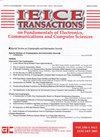An Adaptively Biased OFDM Based on Hartley Transform for Visible Light Communication Systems
IF 0.4
4区 计算机科学
Q4 COMPUTER SCIENCE, HARDWARE & ARCHITECTURE
Ieice Transactions on Fundamentals of Electronics Communications and Computer Sciences
Pub Date : 2023-01-01
DOI:10.1587/transfun.2023eal2059
引用次数: 0
Abstract
Direct-current biased optical orthogonal frequency division multiplexing (DCO-OFDM) converts bipolar OFDM signals into unipolar non-negative signals by introducing a high DC bias, which satisfies the requirement that the signal transmitted by intensity modulated/direct detection (IM/DD) must be positive. However, the high DC bias results in low power efficiency of DCO-OFDM. An adaptively biased optical OFDM was proposed, which could be designed with different biases according to the signal amplitude to improve power efficiency in this letter. The adaptive bias does not need to be taken off deliberately at the receiver, and the interference caused by the adaptive bias will only be placed on the reserved subcarriers, which will not affect the effective information. Moreover, the proposed OFDM uses Hartley transform instead of Fourier transform used in conventional optical OFDM, which makes this OFDM have low computational complexity and high spectral efficiency. The simulation results show that the normalized optical bit energy to noise power ratio (Eb(opt)/N0) required by the proposed OFDM at the bit error rate (BER) of 10-3 is, on average, 7.5 dB and 3.4 dB lower than that of DCO-OFDM and superimposed asymmetrically clipped optical OFDM (ACO-OFDM), respectively.基于Hartley变换的自适应偏置OFDM可见光通信系统
直流偏置光正交频分复用(DCO-OFDM)通过引入高直流偏置将双极OFDM信号转换为单极非负信号,满足强度调制/直接检测(IM/DD)传输的信号必须为正的要求。然而,高直流偏置导致DCO-OFDM的功率效率较低。本文提出了一种自适应偏置光OFDM,可根据信号幅度设计不同的偏置,以提高功率效率。接收端不需要刻意去除自适应偏置,由自适应偏置引起的干扰只会被放置在预留的子载波上,不会影响有效信息。此外,该OFDM采用Hartley变换代替了传统光学OFDM的傅里叶变换,具有计算复杂度低、频谱效率高的特点。仿真结果表明,在误码率(BER)为10-3的情况下,所提出的OFDM系统的归一化光比特能量与噪声功率比(Eb(opt)/N0)平均比DCO-OFDM和ACO-OFDM低7.5 dB和3.4 dB。
本文章由计算机程序翻译,如有差异,请以英文原文为准。
求助全文
约1分钟内获得全文
求助全文
来源期刊

CiteScore
1.10
自引率
20.00%
发文量
137
审稿时长
3.9 months
期刊介绍:
Includes reports on research, developments, and examinations performed by the Society''s members for the specific fields shown in the category list such as detailed below, the contents of which may advance the development of science and industry:
(1) Reports on new theories, experiments with new contents, or extensions of and supplements to conventional theories and experiments.
(2) Reports on development of measurement technology and various applied technologies.
(3) Reports on the planning, design, manufacture, testing, or operation of facilities, machinery, parts, materials, etc.
(4) Presentation of new methods, suggestion of new angles, ideas, systematization, software, or any new facts regarding the above.
 求助内容:
求助内容: 应助结果提醒方式:
应助结果提醒方式:


